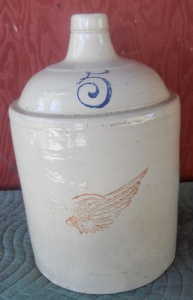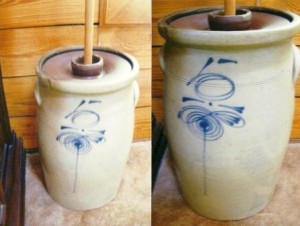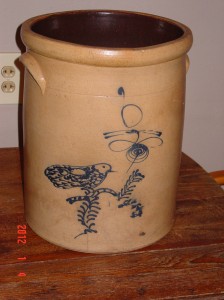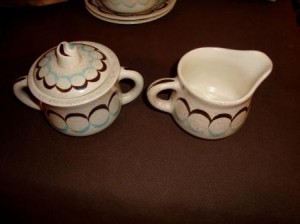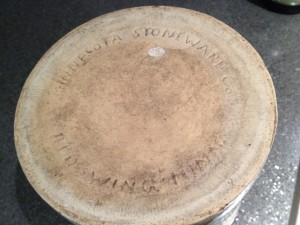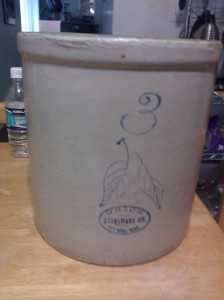Eva Zeisel, groundbreaking designer, dies
By Emily Langer, Published: January 1
Washington Post online
Eva Zeisel, who designed and produced stylish but simple lines of tableware that were credited with bringing a sense of serenity to American dinnertime, died Dec. 30 at her home in New City, N.Y.
Mrs. Zeisel was 105 and had come to America just before World War II, after a harrowing series of adventures in the turbulent Europe of the 1930s.
(Cary Conover/For The Washington Post) – Eva Zeisel, shown in her studio in 2001.
Her daughter, Jean Richards, confirmed the death but said she did not know the medical cause.
Mrs. Zeisel was widely regarded as a master of modern design. Her salt and pepper shakers, creamers and ladles are included in the collections of the Museum of Modern Art in New York. Yet she resisted being characterized as an artist. “Art has more ego to it than what I do,” she once told the New Yorker.
What Mrs. Zeisel did was create everyday objects that fundamentally changed the look of American kitchens and dining rooms.
She brought “a trained designer’s eye and touch to the kind of inexpensive daily goods that were available to everyone,” said Karen Kettering, vice president for Russian art at Sotheby’s and a former curator at the Hillwood Estate, Museum and Gardens in the District, which featured a retrospective of Mrs. Zeisel’s work in 2005.
Mrs. Zeisel received artistic training in her native Hungary in the years after World War I. She moved to the Soviet Union, where she worked in a factory and, after building a reputation as a talented ceramicist, landed a job as art director of the state-run porcelain and glass industries.
While in that position, Mrs. Zeisel was falsely accused of conspiring to assassinate Soviet dictator Joseph Stalin. She spent more than a year in a Soviet prison, much of that time in solitary confinement. Her experience there would deeply inform “Darkness at Noon,” the novel about life under Stalinism written by a childhood friend, Arthur Koestler.
When guards called Mrs. Zeisel from her cell one day, she thought she was about to be executed. Instead, she was released. She fled to Austria, only to be forced to flee again when Adolf Hitler’s Germany annexed that country. Mrs. Zeisel went to England and then to New York, where the design community quickly recognized her talent.
Mrs. Zeisel often said that her work was about the “playful search for beauty.”
Along with some of her contemporary designers, Mrs. Zeisel replaced the florid, gilded style of earlier eras with simple colors. Her most famous table collection from the 1950s is pure white.
Her work often was described with words not usually associated with tableware: human, sensual, voluptuous. Many of her designs are curvaceous and reminiscent of the “feminine midriff,” Kettering said. Mrs. Zeisel designed flower vases with belly buttons. Her bowls were not meant to be stacked but rather to nestle together. Big spoons could be seen as protecting smaller ones.
“All of my work is mother-and-child,” Mrs. Zeisel once said.
Her work reached the height of its popularity during the Cold War. Art critics believe it helped provide a sense of tranquillity during the tensions of the time, Kettering said.
She added that critics have noted a resurgence in the popularity of Mrs. Zeisel’s work since the terrorist attacks of Sept. 11, 2001. A tableware collection from the 1950s was re-released several years ago by Crate and Barrel.
Eva Amalia Striker was born Nov. 13, 1906, in Budapest. She originally trained as a painter but pursued industrial arts, in part to avoid the fate of the starving artist. She was reported to be one of the first female members of the Hungarian guild of chimney sweeps, oven makers, roof tilers, well diggers and potters.
Once in the United States, Mrs. Zeisel broke onto the artistic scene in the 1940s when Castleton China invited her to design a table collection. It would later be displayed at MOMA.
Her first marriage, to Alex Weissberg, ended in divorce. Her second husband, Hans Zeisel, died in 1992 after 54 years of marriage.
Survivors include two children from her second marriage, Jean Richards of New City and John Zeisel of Montreal; and three grandchildren.
Mrs. Zeisel was the author of “Eva Zeisel on Design: The Magic Language of Things.” Her memoir of the Soviet prison is forthcoming, her daughter said.
“I search for beauty,” Mrs. Zeisel told The Washington Post in 2003. “I never wanted to do something grotesque. I never wanted to shock. I wanted my audience to be happy, to be kind.”
News Source: Washington Post
Article also posted in New York Times
Interview aired on Sunday Morning, on January 1, 2012
A Playful Search for Beauty

